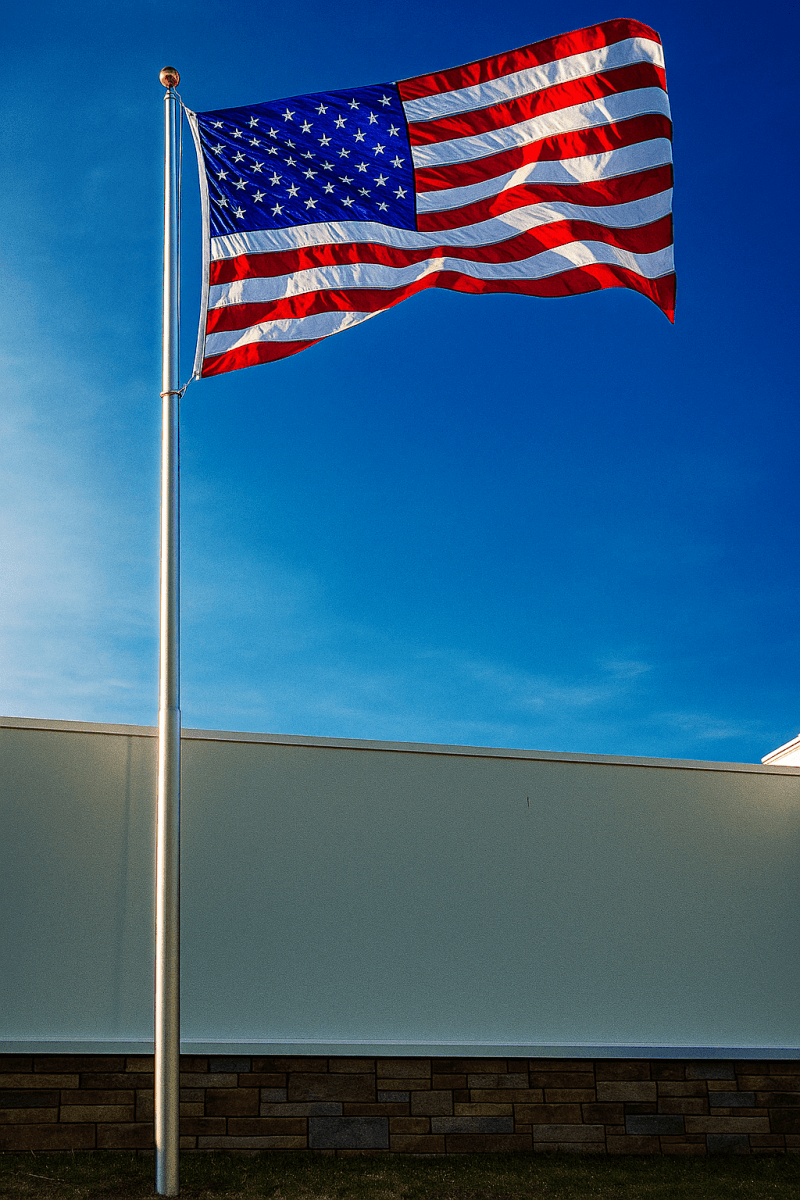Flying the American flag is a powerful symbol of pride, and it all starts with a solid foundation. Anchoring a flagpole correctly is all about ensuring it’s stable and safe. This guide is for homeowners, business owners, and property managers who want to install a flagpole. We will walk you through everything, from selecting the best spot to performing final checks.
Why Proper Anchoring Matters
Understanding why it’s important to properly anchor a heavy-duty fiberglass flagpole is the first step toward successful installation. A solid foundation protects your investment, prevents structural failure, and keeps the pole upright in high winds. Poor anchoring, on the other hand, can turn your flagpole into a serious hazard; it risks property damage and injuries to people during storms.
Strong winds put constant pressure on a flagpole, and only a secure concrete base can withstand the stress. Anchoring the pole correctly ensures it’s stable and upright. It won’t lean, shift, or develop stress cracks over time.
What You’ll Need Before You Begin
You’ll need a shovel or post-hole digger, concrete mix for the foundation, and gravel for water drainage. Don’t forget protective gloves and safety gear for safe handling.
Use a level to keep the ground sleeve and flagpole perfectly vertical. Most flagpole kits include the ground sleeve.
Choosing the right spot is just as important. Pick a location clear of trees, power lines, and buildings. Make sure the flagpole is visible and symbolically placed; this is a statement piece, after all. Check that the soil is stable; rocky or soft ground may need extra prep to ensure a solid base.

The Base: Ground Sleeve vs. Direct Burial
There are two primary methods for setting a flagpole base. The most common and recommended approach for heavy-duty fiberglass poles is using a ground sleeve.
Ground Sleeve Installations
A ground sleeve installation is the standard for most fiberglass flagpoles. This method involves setting a PVC or metal sleeve into a concrete foundation. The flagpole then slides into this sleeve.
The primary benefit of this approach is the ease of maintenance and replacement. If you ever need to remove or replace the flagpole, you can simply lift it out of the sleeve without disturbing the concrete base.
Direct Burial Method
The direct burial method involves setting the flagpole directly into the concrete foundation without a sleeve. This technique is less common for fiberglass poles and is typically used in specific situations where extra stability is necessary. Direct burial creates a permanent installation, which can make future removal or replacement more difficult and costly. For most residential applications, the ground sleeve method provides more than enough stability and offers greater flexibility.
Step-by-Step: Anchor the Fiberglass Flagpole
Now that you have your tools and a chosen location, you can begin the anchoring process. Following these steps carefully will ensure a secure and lasting foundation for the flagpole.
Dig the Hole
The first step is to dig a hole for the concrete base. The depth and diameter of the hole depend on the height of your flagpole; always consult the manufacturer’s recommendations. A general rule is to dig a hole that is about four to six times the diameter of the pole and deep enough to accommodate the ground sleeve and a layer of gravel. The hole can be straight-sided or slightly tapered, so it’s wider at the bottom to increase the pole’s stability.
Prepare the Base
After digging the hole, add a six-inch layer of gravel at the bottom. The gravel layer prevents water from pooling around the base of the sleeve and causing potential issues later. After adding the gravel, place the ground sleeve in the center of the hole. Use your level to ensure it is perfectly vertical before you begin pouring the concrete.
Pour the Concrete
Next, prepare the concrete mix according to the package instructions. Carefully pour the concrete into the hole around the ground sleeve, filling it to ground level. As you pour, periodically check the sleeve with your level to make sure it remains perfectly vertical. A smooth, level finish at the top will give the installation a professional look. It is critical to keep the sleeve centered and plumb throughout this process.
Allow the Concrete To Cure
After pouring the concrete, you must allow it to cure completely. The process takes anywhere between 24 and 48 hours, but it can vary depending on weather conditions. Do not attempt to install the flagpole until the concrete has fully hardened. Rushing this step can compromise the integrity of the foundation and lead to an unstable flagpole.
Install the Fiberglass Flagpole
With the concrete base fully cured, you are ready to install the flagpole. Conduct this final step with care to avoid damaging the pole or the new foundation.
Lower the Pole Into the Ground Sleeve
Carefully lower the flagpole into the ground sleeve. Due to the pole’s size and weight, it is best to have a second person assist you. Use proper lifting techniques to avoid strain or injury. Once the pole is in the sleeve, you can rotate it to the desired orientation.
Conduct Final Checks
After the pole is set, perform a final check to ensure it is plumb. If your flagpole has telescoping or hinged features, test its movement to confirm everything functions correctly. A secure, vertical flagpole is the goal of the entire process.
Tips for Residential Installations
Consider adding landscaping around the base of the flagpole to integrate it into your yard’s design. You might also install lighting to illuminate the flag at night, which is a customary sign of respect. A decorative finial and a truck assembly for raising and lowering the flag can be great add-ons.
Residential fiberglass flagpoles are an excellent choice because they can withstand numerous weather conditions. Their flexibility allows them to bend in high winds without breaking. Understanding the seasonal wind loads in your area can help you appreciate the resilience of the flagpole.

Maintenance and Inspection
Regular maintenance keeps your flagpole looking sharp and standing strong. Monthly inspections take just minutes but go a long way in preventing bigger issues.
Check for wear, cracks, or damage—especially after storms or high winds. If the pole feels loose or wobbles in the sleeve, add shims to secure it. Water pooling at the base? Improve drainage and make sure the ground slopes away from the foundation.
Catching small issues early helps avoid costly repairs and keeps your flag flying proudly for years to come.
A Foundation of Pride
Knowing how to properly anchor a heavy-duty fiberglass flagpole is essential for a safe and lasting installation. By following these steps and the manufacturer’s recommendations, you can create a sturdy foundation that will allow you to fly your flag with pride and respect. A well-installed flagpole is a testament to careful planning and a tribute to the values it represents.







